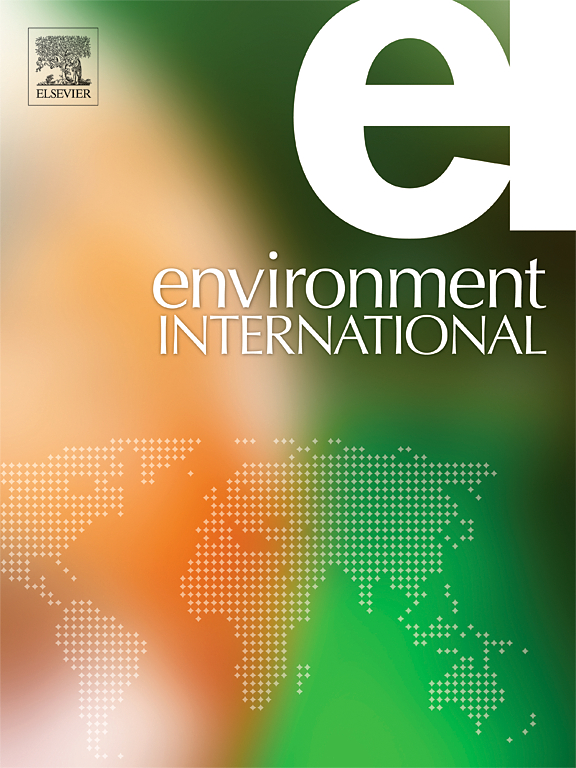Recycling process of decoration and demolition waste is a neglected source for emerging concerns in particulate phase: PAHs as an example
IF 10.3
1区 环境科学与生态学
Q1 ENVIRONMENTAL SCIENCES
引用次数: 0
Abstract
Decoration and demolition waste (DDW) has been widely studied because of its annual surge in output, complex composition, and high utilization potential. DDW recycling is a key element of circular economy, with the potential for emerging pollutants in the particulate phase. Thus, this study selected polycyclic aromatic hydrocarbons (PAHs) as the representative and investigated their emission characteristics and occupational risk in the particulate phase, including 2.5-μm (PM2.5), inhalable (PM10), total suspended particles (TSP), and dust samples of different sizes (75–100 μm, 50–75 μm, and < 50 μm), from dust collectors during DDW recycling. Acenaphthylene (Acy), chrysene (Chr), benz[a]anthracene (BaA), fluoranthene (Fla), pyrene (Pyr), phenanthrene (Phe) were detected in all samples. PM2.5 and dust in 75–100 μm own the highest total occupation risk of 1.51 × 10-13 and 2.07 × 10-15, respectively. Chr and BaA had the control priority with the converted toxicity of 162.82 ng/g and 233.35 ng/g. Moreover, nontarget screening was applied to mining out isophorone, benzophenone, and other carcinogenic micropollutants in the PM2.5, PM10, TSP, and dust samples. Global PAHs from DDW recycling production can reach 193.44 ± 241.80 kg/a under reasonable estimation. This study provides strong evidence that DDW recycling is a neglected source of concern in the particulate phase.


装修和拆迁废物的回收过程是一个被忽视的来源,颗粒物阶段的新问题:多环芳烃为例
装修拆除垃圾因其年产量激增、成分复杂、利用潜力大而受到广泛研究。DDW回收是循环经济的一个关键要素,在颗粒阶段有可能出现新的污染物。因此,本研究以多环芳烃(PAHs)为代表,研究了其在DDW回收过程中颗粒阶段的排放特征和职业风险,包括2.5 μm (PM2.5)、可吸入性(PM10)、总悬浮颗粒(TSP)和不同粒径的粉尘样品(75-100 μm、50 - 75 μm和 <; 50 μm)。所有样品均检测到苊(Acy)、chrysene (Chr)、苯并[a]蒽(BaA)、荧光蒽(Fla)、芘(Pyr)、菲(Phe)。75 ~ 100 μm PM2.5和粉尘的总职业风险最高,分别为1.51 × 10-13和2.07 × 10-15。Chr和BaA的转化毒性分别为162.82 ng/g和233.35 ng/g。此外,采用非靶向筛选方法,对PM2.5、PM10、TSP和粉尘样品中的异虫酮、二苯甲酮等致癌微污染物进行了挖掘。合理估计全球DDW回收生产产生的多环芳烃可达193.44 ± 241.80 kg/a。这项研究提供了强有力的证据,表明DDW回收是一个被忽视的来源,在颗粒阶段的关注。
本文章由计算机程序翻译,如有差异,请以英文原文为准。
求助全文
约1分钟内获得全文
求助全文
来源期刊

Environment International
环境科学-环境科学
CiteScore
21.90
自引率
3.40%
发文量
734
审稿时长
2.8 months
期刊介绍:
Environmental Health publishes manuscripts focusing on critical aspects of environmental and occupational medicine, including studies in toxicology and epidemiology, to illuminate the human health implications of exposure to environmental hazards. The journal adopts an open-access model and practices open peer review.
It caters to scientists and practitioners across all environmental science domains, directly or indirectly impacting human health and well-being. With a commitment to enhancing the prevention of environmentally-related health risks, Environmental Health serves as a public health journal for the community and scientists engaged in matters of public health significance concerning the environment.
 求助内容:
求助内容: 应助结果提醒方式:
应助结果提醒方式:


